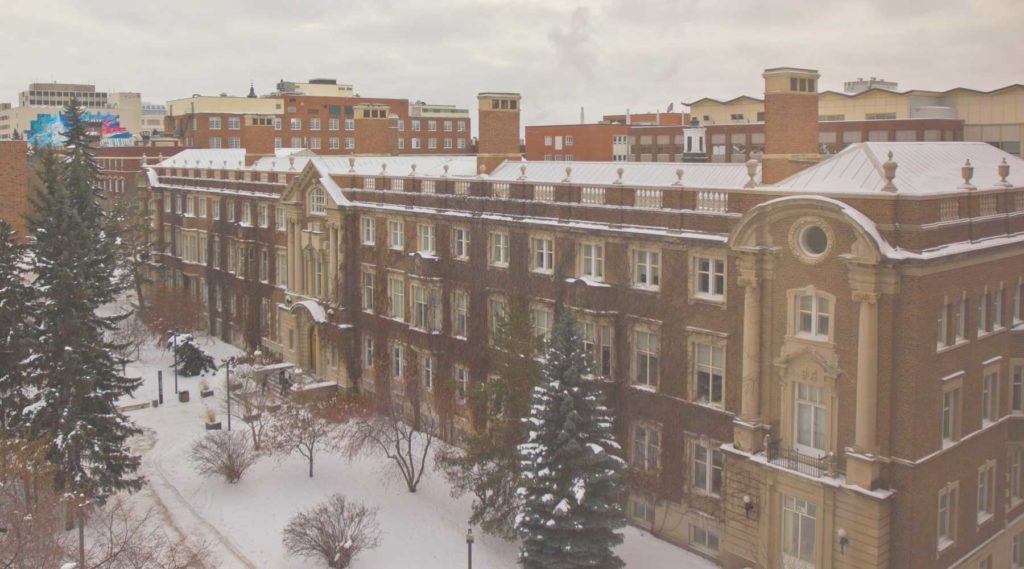
September 23, 1908 marked the beginning for the University of Alberta. Located in Edmonton, the capital of Alberta, the U of A is a public research university in Canada. Consisting of 258 acres of land, the University site was decided on being situated at the edge of the North Saskatchewan River Valley, in a beautifully wooded park that complimented the architectural scheme suitable for its university purposes.
Since being founded in 1908 by Alexander Cameron Rutherford, the first premier of Alberta, and Henry Marshall Troy, the university’s first president, the university has grown in Edmonton from the single North Campus to include francophone Campus Saint-Jean, agricultural studies on South Campus, Enterprise Square downtown, and an hour’s drive away in rural Camrose is the Augustana Campus. In total it comprises a total of 150 buildings spread over four campuses.
During the very beginning of operations at the University, forty-five students attended classes in English, mathematics and modern languages, on the top floor of the Queen Alexandra Elementary School in Strathcona while the first campus building, Athabasca Hall, was under construction. Of the 45 students in the University’s cohort in 1908, seven were women; these original seven introduced a type of women’s sorority, called Seven Independent Spinsters (S.I.S), with the intention of supporting the women’s social and academic needs. In 1909, this group was later renamed the Wuaneita Society, which continued to function as a women’s support group for the relatively few female students on campus, and was a present club until 1973. The group organized lectures, social events, fundraisers and eventually operated its own women-only study hall in the old Students’ Union Building. However, the name, culture and traditions of the Wuaneita Society were heavily appropriated from stereotypes of Cree culture, and was using First Nations culture to build a bond among female students on campus. Throughout the 60s and 70s, as the University’s female population grew, the club’s thousands of members clashed over the group’s purpose, and consequently the club was closed down in 1973.
Dating back to the emergence of sport and athletics at the University of Alberta stretches all the way back to the start of the University itself. Evergreen and gold were unanimously selected for the school’s identity, which has fabricated the unquestionably famous phrase “Green and Gold” at the U of A, and has become a notion of it’s excellence.
The founding stones of athletics were put in place by the first intake of students in 1908, and thus formed organized sport and competition under the governance of the Athletic Society in the new university. To date, the UofA Golden Bears and Pandas Athletics is one of the most comprehensive, wide-ranging, consistent and successful programs in all of Canadian university sport. Not only have the countless national championship wins in Canada, broken records and renowned athletics programs given the University their credibility on the field, but also in the classroom, with leading numbers in producing the highest total of Academic All-Canadian students in the country.
Today, the University of Alberta is one of Canada’s top universities, with its reputation for excellence across humanities, sciences, creative arts, business, engineering and health sciences.
At a quick glance, standout programs of this university include Food Science and Technology, Computing Science, and Land Reclamation. In Food Science and Technology, students learn how to apply chemistry, microbiology and engineering to the technological processes involved in the manufacturing, preservation and distribution of food; other topics include product development, nutrition and food safety. In a specialized program like Computing Science, students can combine their study of the subject with a wide range of other disciplines, such as anthropology, film or medicine (and paid internship is available!). Lastly, in the renowned Land Reclamation major, students learn how to maintain healthy environments and restore damaged ecosystems through such means as soil reclamation, re-vegetation, conservation measures and land-use planning. In other global rankings, sports-related courses ranked a nine, and paleontology ranking a 3. The University is also the only one in Canada to offer programs in native studies, through which students can learn about the aboriginal experience, including issues facing Indigenous peoples in Canada, language, culture, history and more.
[INSERT specific top courses paragraphs here]
With 400 undergraduate, graduate and professional programs in 18 faculties, and over 100 years of history, the University of Alberta attracts the best and brightest minds from around the globe. As this university consistently ranks among the Top 5 universities in Canada, it offers renowned opportunities for undergraduate students to achieve great things in a supportive and multicultural atmosphere, within a vibrant environment of excellence.